The Hydrolyzed Oat Protein Market is estimated to be valued at USD 1.9 billion in 2025 and is projected to reach USD 2.7 billion by 2035, registering a compound annual growth rate (CAGR) of 3.5% over the forecast period.
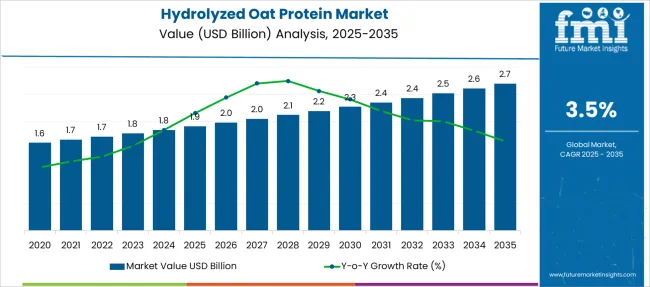
| Metric | Value |
|---|---|
| Hydrolyzed Oat Protein Market Estimated Value in (2025 E) | USD 1.9 billion |
| Hydrolyzed Oat Protein Market Forecast Value in (2035 F) | USD 2.7 billion |
| Forecast CAGR (2025 to 2035) | 3.5% |
The hydrolyzed oat protein market is gaining traction globally, supported by increased demand for plant-based, multifunctional ingredients in personal care and wellness formulations. Rising consumer awareness around skin sensitivity, product origin, and ingredient transparency has prompted manufacturers to prioritize naturally derived proteins that offer both performance and safety.
The shift toward clean-label and vegan cosmetic formulations is playing a pivotal role in expanding adoption across skin and hair care segments. In addition, strong emphasis on dermatologically safe products and allergen-free alternatives is reinforcing the position of hydrolyzed oat protein in premium formulations.
The market outlook remains positive, with sustained innovation in protein extraction techniques, regulatory support for botanical actives, and the expanding influence of e-commerce channels expected to enhance market reach and formulation diversity over the forecast period.
The market is segmented by Application and Sales Channel and region. By Application, the market is divided into Cosmetics, Toiletries, and Detergents. In terms of Sales Channel, the market is classified into Online and Offline. Regionally, the market is classified into North America, Latin America, Western Europe, Eastern Europe, Balkan & Baltic Countries, Russia & Belarus, Central Asia, East Asia, South Asia & Pacific, and the Middle East & Africa.
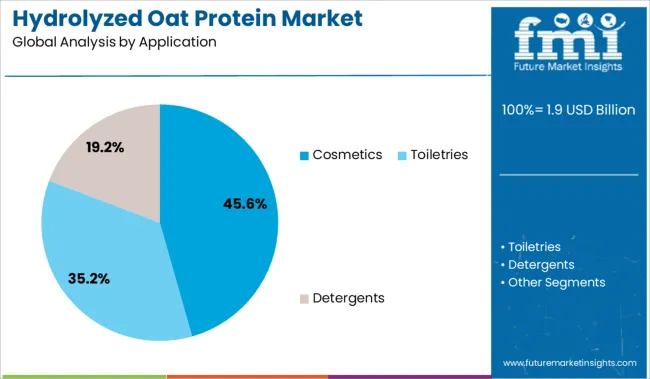
Cosmetics applications are projected to account for 45.6% of the total revenue share in the hydrolyzed oat protein market by 2025, making it the most dominant segment. This leadership is being driven by the ingredient’s proven efficacy in enhancing skin moisture retention, reducing irritation, and supporting anti-aging claims.
Its compatibility with a wide range of emulsions, gels, and serums has led to widespread usage in both facial and body care products. Moreover, the ingredient’s film-forming and barrier-reinforcing capabilities are particularly valued in personal care routines focused on sensitive skin and environmentally induced stress.
The clean beauty movement and increasing avoidance of synthetic proteins have further solidified the role of hydrolyzed oat protein in cosmetic innovation pipelines. Regulatory acceptance across major markets has also facilitated consistent product launches and broader consumer acceptance within the personal care landscape.
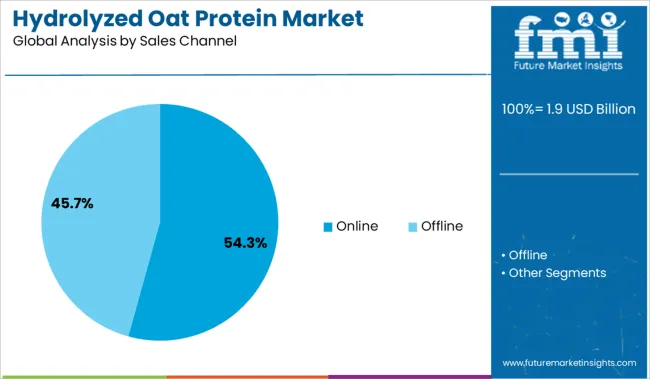
Online sales channels are expected to contribute 54.3% of the market’s revenue in 2025, establishing them as the leading distribution segment. This growth is being accelerated by the surge in direct-to-consumer brand strategies, increased reliance on e-commerce platforms, and the rise of informed purchasing decisions based on digital content.
Consumer preference for home delivery, ingredient research, and product reviews has led to a significant shift toward online purchasing behavior particularly in health-conscious and beauty-centric categories. Online platforms offer greater visibility for niche and ingredient-focused brands, allowing hydrolyzed oat protein-based formulations to reach a broader, targeted audience.
Enhanced personalization features, dynamic promotions, and influencer-driven marketing have further improved conversion rates. As digital retail ecosystems become more sophisticated, the online channel is expected to remain the primary growth driver for hydrolyzed oat protein product distribution.
In the Historical outlook of Hydrolyzed Oat Protein market, the value increased from USD 1,495.1 Million in 2020 to USD 1,676.2 Million in 2024. The CAGR (2020 to 2024) is observed to be 2.9%.
Oats have historically been thought of as a nutritious meal, but as their ubiquity has grown recently, so has the recognition of them as an element with very little allergenic potential but very high, proven therapeutic benefit. This is anticipated to drive the market's expansion throughout the projected period.
Oats are used more frequently to maintain skin since they may mend and soothe the skin, which lowers inflammation and redness. Additionally, hydrolyzed oat protein is being utilized more frequently to create anti-aging and anti-wrinkle creams, which is anticipated to significantly support market expansion over the coming years.
For the Future projection of Hydrolyzed Oat Protein market, the value increased from USD 1,724.8 Million in 2025 to USD 2,433.0 Million in 2035. The CAGR (2025 to 2035) is estimated to be 3.5%.
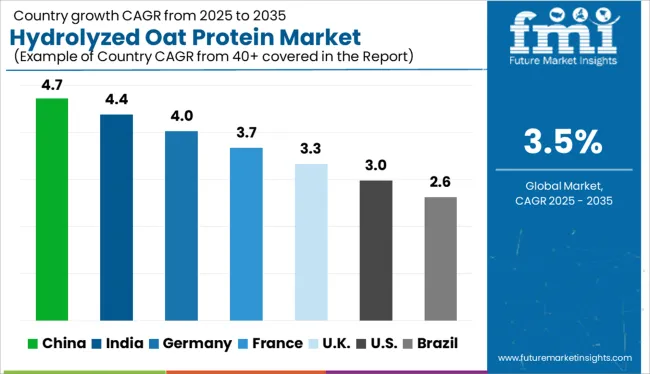
In the North American market growth to the increasing popularity of hydrolyzed oat protein as a dietary supplement and an ingredient in sports nutrition products. The North American market is being driven by the USA, where there is a growing demand for healthy and natural food products.
The majority of hydrolyzed oat protein products on the market are designed for athletes and bodybuilders. However, there is also a growing demand for hydrolyzed oat protein among people who are looking to improve their overall health and wellness.
The USA contributes 30.0% of the total revenue for Hydrolyzed Oat Protein Market.
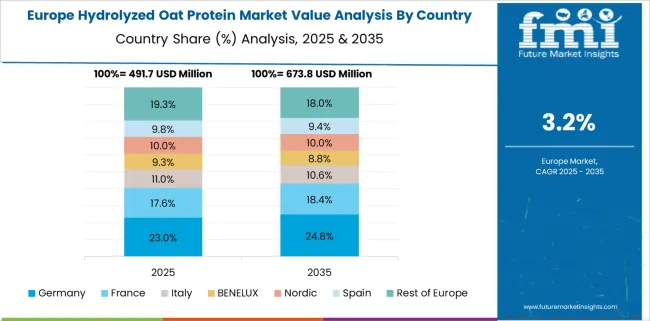
Europe is anticipated to hold the largest market share in the hydrolyzed oat protein market during the forecast period, followed by North America. However, due to the region’s mature market, moderate growth is anticipated.
Consumers around the world view personal care products that contain components that are sourced from food or plants as being healthier and more valuable. They are favoring products with a high proportion of natural ingredients, which is predicted to drive market expansion throughout the projection period.
Germany contributes 25.1% to Hydrolyzed Oat Protein market and United Kingdom CAGR for the forecast period is 3.8%.
Asia Pacific is expected to be the fastest-growing market for hydrolyzed oat protein during the forecast period.
The increasing demand for healthy and nutritious food, rising awareness about the health benefits of hydrolyzed oat protein, and the growing preference for plant-based proteins are the major factors driving the growth of the Asia Pacific hydrolyzed oat protein market.
Japan's contribution to Hydrolyzed Oat Protein market is 10.1% of the total market share, India and China are market drivers in the Asia Pacific and their latest CAGR in Hydrolyzed Oat Protein market is 5.8% and 5.5% respectively.
The Latin American market for hydrolyzed oat protein is in a state of flux. A number of factors, including changing consumer preferences and the rise of new competitors, are leading to changes in the landscape.
In terms of consumer preference, there is a growing demand for healthier and more natural products. This is especially true in Brazil, where a growing middle class is increasingly interested in health and wellness. As a result, hydrolyzed oat protein, which is seen as a healthy and natural alternative to other proteins, is becoming more popular.
Overall, the Latin American market for hydrolyzed oat protein is evolving rapidly.
The expansion into new markets is important for the long-term growth of the company. The Middle East and Africa(MEA) & RoW are also looking to develop new products that can be used in a variety of industries. For example, they are working on a hydrolyzed oat protein powder that can be used as a food additive or as a dietary supplement.
From the Oceania region, Australia is contributing 2.7% of the total revenue of Hydrolyzed Oat Protein market.
The skincare and hair care segments of the cosmetics market are further divided. The skin care sub-segment of both of these is anticipated to have a significant market share over the projection period. The expansion of the skin care sub-segment is anticipated to be fueled by an increase in the use of hydrolyzed oat protein in moisturizing creams and sun care products.
Additionally, increasing demand for anti-wrinkle and anti-aging products made with natural food ingredients is anticipated to help the growth of the skincare market during the forecast period. Additionally, the sub-segment for hair care is anticipated to increase favorably in the near future.
Hydrolyzed oat protein is a popular choice for those looking for an alternative to whey or soy protein. Here are some of the benefits of hydrolyzed oat protein:
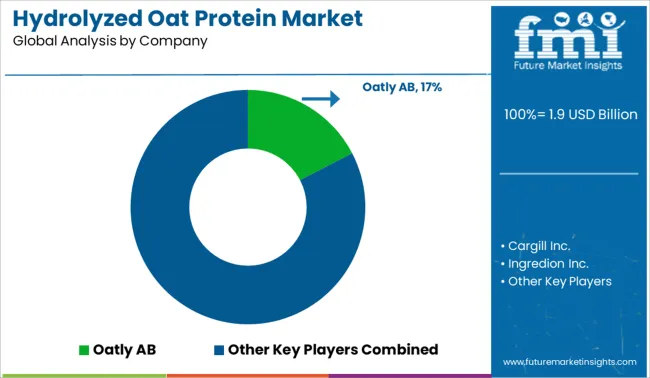
The global hydrolyzed oat protein market is highly competitive with the presence of numerous small and large players. The key players in the market are Oatly AB, Cargill Inc., DuPont Nutrition & Biosciences A/S, and Ingredion Inc. These companies account for a major share of the market.
New competitors are also entering the market, offering products that are similar to hydrolyzed oat protein but at lower prices. This is putting pressure on existing players to either lower their prices or differentiate their products.
| Attribute | Details |
|---|---|
| Forecast Period | 2025 to 2035 |
| Historical Data Available for | 2020 to 2025 |
| Market Analysis | USD Million for Value and Units for Volume |
| Key Regions Covered |
North America; Latin America; Europe; Asia Pacific; Middle East and Africa(MEA); RoW |
| Key Countries Covered |
USA, Canada, Mexico, Germany, United Kingdom, France, Russia, Brazil, Argentina, Japan, Australia, China, India |
| Key Segments Covered |
Application, Sales Channel, Region |
| Key Companies Profiled |
Oatly AB; Cargill Inc.; Ingredion Inc; DuPont Nutrition & Biosciences A/S; Lotioncrafter LLC; Lonza Group; Provital Group; Sinerga S.p.A.; BioOrganic Concepts; Croda International Plc; Induchem companies |
| Report Coverage | Drivers, Restraints, Opportunities and Threats Analysis, Market Forecast, Company Share Analysis, Market Dynamics and Challenges, Competitive Landscape, and Strategic Growth Initiatives |
| Customization & Pricing | Available upon Request |
The global hydrolyzed oat protein market is estimated to be valued at USD 1.9 billion in 2025.
The market size for the hydrolyzed oat protein market is projected to reach USD 2.7 billion by 2035.
The hydrolyzed oat protein market is expected to grow at a 3.5% CAGR between 2025 and 2035.
The key product types in hydrolyzed oat protein market are cosmetics, _skin-care, _hair-care, toiletries and detergents.
In terms of sales channel, online segment to command 54.3% share in the hydrolyzed oat protein market in 2025.






Our Research Products

The "Full Research Suite" delivers actionable market intel, deep dives on markets or technologies, so clients act faster, cut risk, and unlock growth.

The Leaderboard benchmarks and ranks top vendors, classifying them as Established Leaders, Leading Challengers, or Disruptors & Challengers.

Locates where complements amplify value and substitutes erode it, forecasting net impact by horizon

We deliver granular, decision-grade intel: market sizing, 5-year forecasts, pricing, adoption, usage, revenue, and operational KPIs—plus competitor tracking, regulation, and value chains—across 60 countries broadly.

Spot the shifts before they hit your P&L. We track inflection points, adoption curves, pricing moves, and ecosystem plays to show where demand is heading, why it is changing, and what to do next across high-growth markets and disruptive tech

Real-time reads of user behavior. We track shifting priorities, perceptions of today’s and next-gen services, and provider experience, then pace how fast tech moves from trial to adoption, blending buyer, consumer, and channel inputs with social signals (#WhySwitch, #UX).

Partner with our analyst team to build a custom report designed around your business priorities. From analysing market trends to assessing competitors or crafting bespoke datasets, we tailor insights to your needs.
Supplier Intelligence
Discovery & Profiling
Capacity & Footprint
Performance & Risk
Compliance & Governance
Commercial Readiness
Who Supplies Whom
Scorecards & Shortlists
Playbooks & Docs
Category Intelligence
Definition & Scope
Demand & Use Cases
Cost Drivers
Market Structure
Supply Chain Map
Trade & Policy
Operating Norms
Deliverables
Buyer Intelligence
Account Basics
Spend & Scope
Procurement Model
Vendor Requirements
Terms & Policies
Entry Strategy
Pain Points & Triggers
Outputs
Pricing Analysis
Benchmarks
Trends
Should-Cost
Indexation
Landed Cost
Commercial Terms
Deliverables
Brand Analysis
Positioning & Value Prop
Share & Presence
Customer Evidence
Go-to-Market
Digital & Reputation
Compliance & Trust
KPIs & Gaps
Outputs
Full Research Suite comprises of:
Market outlook & trends analysis
Interviews & case studies
Strategic recommendations
Vendor profiles & capabilities analysis
5-year forecasts
8 regions and 60+ country-level data splits
Market segment data splits
12 months of continuous data updates
DELIVERED AS:
PDF EXCEL ONLINE
Hydrolyzed Casein Market Size, Growth, and Forecast for 2025 to 2035
Hydrolyzed Egg Market Trends – Functional Benefits & Applications 2025 to 2035
Hydrolyzed Starch Market Trends - Business Progress & Growth
Hydrolyzed Bovine Collagen Market
Hydrolyzed Silk Proteins Market Analysis - Size, Share, and Forecast Outlook 2025 to 2035
Hydrolyzed Corn Protein Market Analysis - Growth & Applications 2025 to 2035
Hydrolyzed Whey Protein Market Analysis by Product Form, Application, Sales Channel and Region through 2035
Hydrolyzed Animal Protein Market Analysis - Size, Share, and Forecast Outlook 2025 to 2035
Hydrolyzed Vegetable Proteins Market Size and Share Forecast Outlook 2025 to 2035
Hydrolyzed Vegetable Protein Market Analysis - Size, Share, and Forecast Outlook 2025 to 2035
Competitive Landscape of Hydrolyzed Vegetable Protein Providers
UK Hydrolyzed Vegetable Protein Market Trends – Demand, Innovations & Forecast 2025-2035
USA Hydrolyzed Vegetable Protein Market Insights – Size, Share & Industry Growth 2025-2035
ASEAN Hydrolyzed Vegetable Protein Market Report – Demand, Growth & Industry Outlook 2025-2035
Europe Hydrolyzed Vegetable Protein Market Analysis – Size, Share & Trends 2025-2035
Partially Hydrolyzed Guar Gum Market Size and Share Forecast Outlook 2025 to 2035
Australia Hydrolyzed Vegetable Protein Market Growth – Innovations, Trends & Forecast 2025-2035
Enzymatically Hydrolyzed Carboxymethyl Cellulose Market
Latin America Hydrolyzed Vegetable Protein Market Insights – Size & Forecast 2025–2035
Middle East & Africa Hydrolyzed Bovine Collagen Market Size and Share Forecast Outlook 2025 to 2035

Thank you!
You will receive an email from our Business Development Manager. Please be sure to check your SPAM/JUNK folder too.
Chat With
MaRIA